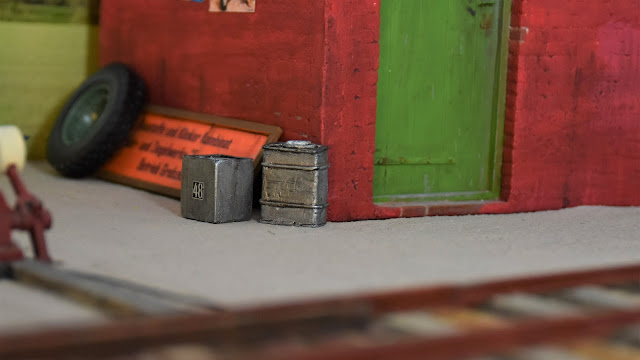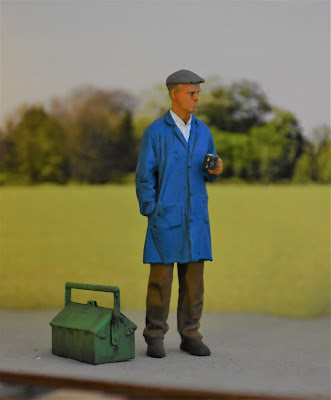In January I installed a wooden fence next to the fuel shed and I speculated that the area between them would soon fill with used oil cans and scrap. Nothing has so far happened, but I have now aquired some petrol or oil canisters and a few of them are even painted and weathered.
 |
| Two canisters placed in front of the brick shed. Along with other parts they are destined for permanent placement between shed and fence. |
The canisters are resin items from the German manufacturer Imperial Modellbau that sells its products through eBay. Having not had the chance to handle any products from Imperial Modellbau before, I took the chance and ordered a small selection of items that caught my interest. Some of them needed for a Ford A lorry project, others for use later on the layout and a variety of vehicles.
 |
| A selection of items from Imperial Modellbau. The tool box is assembled from resin and white metal parts. |
My complete order consisted of 9 bags with the following contents:
- Ölkanister 5 pieces in resin
- Kleine Ölkännchen 2 pieces in white metal
- Schraubenschlüssel-Set 2 sprues in white metal
- Ölkännchen für Werkstatt 1 large in white metal
- Werkzeugkasten 1 open in resin
- Ölkanister 2 pieces in resin
- Ölkanne für Werkstatt 2 pieces in resin
- Große Ölkanne 1 piece in white metal
- Werkzeugkasten 1 piece with lid, resin and white metal
 |
| The bags are just out of the DVD cover. |
The parts came in small zip lock plastic bags safely packed for transport in an old DVD cover. When examining the parts I noticed a clear difference between the resin and white metal items. The white metal castings are quite good with minimal mould lines and flash. The resin parts on the other hand are to a certain extent marred by holes from air bubbles and other casting flaws. I will no doubt have to work on the resin petrol canisters to make them better whereas the white metal parts basically just needs a coat of primer, paint and weathering.
 |
| Painted tool box with oil wash applied. More weathering of the box will follow. Is the box perhaps a bit on the large side? |











